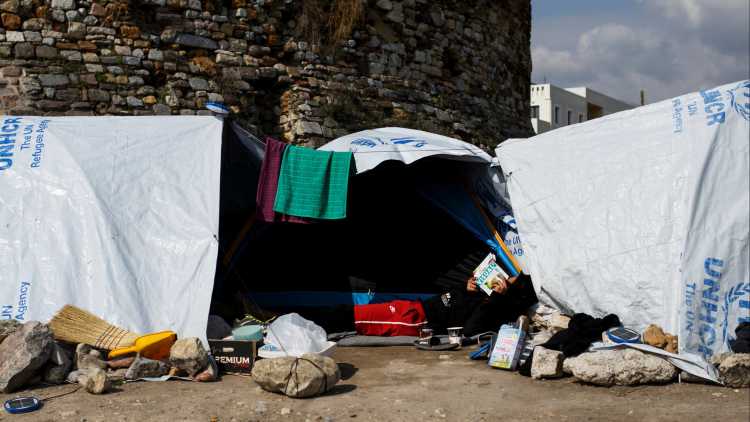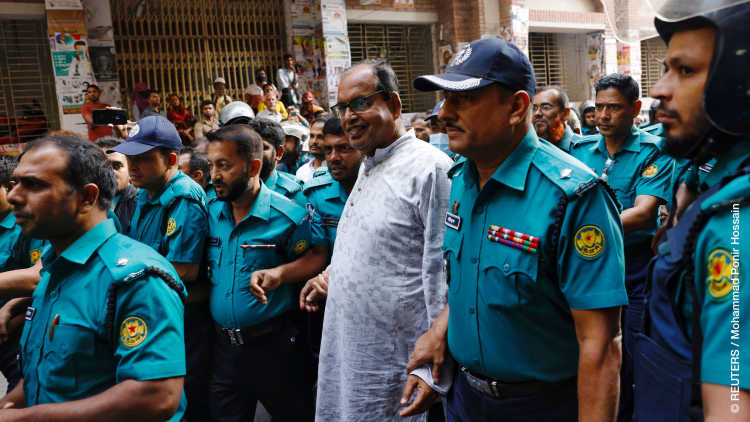- Startseite
- Publikationen
- GIGA Focus
- After Humanitarianism: Bangladesh’s Evolving Rohingya Policy
GIGA Focus Asien
Die Nachwehen der Humanität: Veränderungen in Bangladeschs Rohingya-Politik
Nummer 6 | 2020 | ISSN: 1862-359X

Seit August 2017 hat Bangladesch im größten Flüchtlingscamp der Welt in einer grenznahen Unruheregion 1,1 Millionen Rohingyas aus Myanmar aufgenommen. Nachdem die geplanten Rückführungen ins Stocken geraten sind, ist die enttäuschte Regierung Bangladeschs nun auf eine Politik der Umverteilung von Flüchtlingen und einer strengeren Überwachung der Lager umgeschwenkt. So wirksam diese Neuausrichtung in der kurzen Frist sein mag, dürfte sie längerfristig Bangladeschs Beziehungen mit den Geberländern belasten und die Menschenrechtssituation der Rohingyas verschlechtern.
Die Regierung Bangladeschs plant, zum Ende der Monsunsaison Anfang November mit der Umsiedlung der Flüchtlinge nach Bhashan Char zu beginnen – eine abgelegene und hochwassergefährdete Insel in der Bucht von Bengalen. Durch die Insellage werden die umgesiedelten Flüchtlinge von ihren heimischen Verwandten abgeschnitten. Zugleich ist mit höheren Sicherheitsrisiken zu rechnen, was den Transport von Hilfsgütern, medizinische Notfallhilfe und Unterstützung im Fall von Naturkatastrophen angeht.
Die Umsiedlung könnte die stark überlasteten Flüchtlingslager, die seit Mai 2020 zudem einen Anstieg von COVID-19-Fällen erleben, entlasten. Andererseits setzt der Schritt aufgrund der damit verbundenen Bedenken in Sachen Menschenrechts- und Flüchtlingsschutz Bangladeschs Beziehungen zu seinen internationalen Partnern aufs Spiel. Dabei drängt sich der Vergleich mit der Situation auf der griechischen Insel Lesbos nach dem verheerenden Brand im Lager Moria auf.
Nach gewalttätigen Auseinandersetzungen zwischen rivalisierenden Flüchtlingsgruppen, die um territoriale Kontrolle und Anteile an einem wachsenden illegalen Drogenmarkt kämpfen, hat die Regierung eine striktere Überwachung der Lager angeordnet.
Seit Jahrzehnten gilt Bangladesch als Sprungbrett für Rohingyas, die in muslimische Nachbarländer weiter migrieren wollen. Die schwierige Situation der Flüchtlinge und die Abriegelungsmaßnahmen im Zuge der COVID-19-Pandemie haben den Migrationsdruck zuletzt noch erhöht. Die Rohingya-Krise könnte sich so zu einer neuen „Boat People“-Krise regionalen Ausmaßes auswachsen.
Fazit
In dem stark nationalistisch aufgeheizten politischen Klima, das derzeit in Myanmar herrscht, ist eine Rückkehr der Rohingya-Flüchtlinge höchst umstritten und daher wenig aussichtsreich. Europäische Entscheidungsträger sollten sich gegenüber der politischen Führung Myanmars deshalb für eine nachhaltige Lösung der Rohingya-Krise einsetzen. Auch sollte die EU abgestimmte und zielgerichtete Anstrengungen unternehmen, um Bangladesch von seinem kontroversen Umsiedlungsplan abzubringen. Zugleich sollte sie ihre finanziellen Zusagen einhalten, um zur Verbesserung der Sicherheitslage und der Lebensbedingungen in den Flüchtlingslagern beizutragen.
A Humanitarian Catastrophe
Since August 2017 Bangladesh has hosted more than 1.1 million Rohingya refugees, members of a Muslim ethnic minority from Myanmar who fled the northern Rakhine State when the Burmese Army launched a security operation against the Rohingya insurgent group called the Arakan Rohingya Salvation Army (Fortify Rights 2018).
The Rohingya have sought refuge in the coastal district of Cox’s Bazaar in southeastern Bangladesh for decades, escaping brutal living conditions in Rakhine State and periodic crackdowns by the Burmese military. Before the 2017 operation, there were at least three targeted military operations by the Burmese Army against the Rohingya, carried out in 1978, 1992, and 2016, respectively. However, the 2017 crackdown surpassed all previous military measures for its sheer scale of attacks and the intensity of violence perpetrated against the entire community. The disproportionate offensive against unarmed civilians has been labelled as “a textbook example of ethnic cleansing” by the then UN High Commissioner for Human Rights, Zeid Ra’ad Al Hussein. The resulting mass exodus of nearly 710,000 people constituted the largest refugee movement across an international border since the Rwandan genocide in 1994. This latest influx of refugees joined the approximately 200,000 Rohingya already living in Bangladesh, including 35,000 registered refugees from the 1992 exodus and another 74,000 who arrived after violence broke out in Rakhine State in October 2016.
In Myanmar, the heavy-handed treatment of the Rohingya has widespread popular support. The dominant vernacular narrative of Myanmar characterises the Rohingya as illegal immigrants and Islamist terrorists. This issue is usually described in stark and uncompromising terms, with demonisation of the Rohingya one of the most common outcomes. The Rohingya are not recognised by Myanmar’s 1982 Citizenship Law, which officially acknowledges 135 “national races” of Myanmar (Cheesman 2017). The general population consider them as “Bengalis” – foreign interlopers from Bangladesh – who are on a mission to take over Rakhine State. Adding to this fear is the threat narrative propagated by members of Buddhist nationalist movements such as MaBaTha (the Organisation for the Protection of Race and Religion) who staunchly advocate for an active fortification of Buddhism against all foreign elements – Muslims in general and Rohingya in particular (Walton and Hayward 2014). Due to these tense interactions, the root causes of the Rohingya crisis – connected to citizenship and formal inclusion – are unlikely to be resolved any time soon, forcing Bangladesh to come to grips with a protracted refugee situation.
Against this backdrop, this article analyses the evolving policy responses of the Bangladeshi government to the Rohingya refugee situation. It shows that as the displacement enters its fourth year, the Bangladeshi government is facing pressure to adjust its short-term humanitarian policies in order to address the protracted and complex security, human rights and healthcare challenges emerging from hosting this large population amidst a global pandemic. However, some of the proposed solutions could further exacerbate existing vulnerabilities faced by the refugees and have adverse implications for Bangladesh’s relations with international donors.
Realities on the Ground
Since 2017 the Bangladeshi government under Prime Minister Sheikh Hasina has been overseeing one of the largest refugee responses in the world. Bangladesh’s initial strategy of dealing with the crisis was twofold: first, refugees were segregated into encamped settlements and, with the support of international aid, provided short-term humanitarian assistance focusing on food, shelter and basic healthcare; second, bilateral and international pressure was exercised on Myanmar that promoted refugees’ safe and voluntary repatriation. Three years later, these strategies have led to an overwhelmingly aid-dependent displaced population that has little say in camp management or repatriation processes. So far, there have been two formal efforts to start the repatriation process: in November 2018 and again in August 2019. On each occasion, the bilaterally agreed-upon official arrangements were put on hold after thousands of refugees staged protests refusing to return to Myanmar unless questions regarding their citizenship and other civic rights were resolved. The UN’s Special Rapporteur on Myanmar declared that the conditions in northern Rakhine State were unsuitable for safe return (Lederer 2019). Currently, there is no timeline or plan for the repatriation to resume.
The sprawling Kutupalong–Balukhali mega-camp, located in the district of Cox’s Bazaar, is the largest refugee settlement in the world. There are around 130 NGOs working in the camps alongside the Bangladeshi government, including 69 international NGOs and 12 UN agencies. More than 600,000 refugees live on a 13-square-kilometre landmass, making Kutupalong one of the most densely populated areas of Bangladesh. Most of these settlements were built upon cleared paddy fields or levelled forested areas. The refugees live in substandard housing made of bamboo and tarpaulin, following a Bangladeshi government ban on permanent structures inside the camps. The houses often collapse during the monsoon months (between June and October) when torrential rain and tropical storms hit the region. Due to its long coastline along the Bay of Bengal, Cox’s Bazaar is also highly exposed to natural hazards and extreme weather events, including seasonal landslides, monsoon flooding, and cyclones. There are no cyclone shelters inside the camps or a written evacuation plan for refugees at risk. Hence, a medium-intensity cyclone, if it directly crosses through the camp area, could cause serious harm.
Apart from natural disasters, there are growing concerns about worsening relations between the Rohingya and their host communities. In recent times, conflicts have emerged over resource scarcity, increased prices of goods and accommodation, disruption of services (transportation and education), and labour displacement. The camps are also becoming conflict grounds for rival refugee gangs fighting over territorial control and a share of the burgeoning illegal drug trade, which has raised security concerns within the government. So far, more than 200 Rohingya have been shot and killed, either in confrontations with Bangladeshi law-enforcement agencies or in internal gang wars. In October 2020 violent clashes broke out between rival factions over the control of illegal drug business in the camp, leaving seven people dead and another 2,000 displaced (Amnesty International 2020). These incidents have exposed the vulnerability of the refugee population to the whims of criminal gangs, especially at night, when government officials and aid agencies withdraw from the camp sites.
One of the long-standing solutions proposed by the Bangladeshi government to address the changing security dynamics, the increased congestion, and the unforeseen environmental challenges in the camps has been to relocate one-tenth of the camp population to a new site. Bhashan Char, the envisaged destination, is a remote island in the Bay of Bengal. The government argues that the newly built facilities there will reduce pressure on resources, along with improving living conditions and providing livelihood opportunities for the refugees.
The Island
As far back as 2015, the Bangladeshi government had already conceived of a plan to relocate 32,000 registered Rohingya refugees – unrepatriated from the 1992 exodus – from UNHCR-administered camps to a remote, uninhabited island in the Bay of Bengal. It was subsequently named “Bhashan Char” – “Floating Island.”
The island is made up of sediment carried through the Meghna River estuary and is located approximately 30 kilometres from the nearest inhabited island. Before the Rohingya relocation plans came about, Bhashan Char, which appeared on the surface of the river only 11 years ago, was considered inaccessible, unstable, and unliveable. According to geological experts, it takes at least 30 to 40 years for a silt island to become stable enough for human habitation.
Facing strong international criticism, Bangladesh shelved the initial relocation plan in 2016. However, in October of that year, Myanmar’s army launched security operations against a newly emerged Rohingya insurgent group called Harakah al-Yaqin – currently known as ARSA – after it attacked nine Border Guard outposts in Rakhine State (International Crisis Group 2016). Similar to 2017, the 2016 crackdown also systematically targeted civilian villages, causing approximately 74,000 Rohingya to flee to Bangladesh. Given these circumstances, the Bangladeshi government revived its 2016 Bhashan Char plan, aiming to “temporarily” relocate the new arrivals to the island until they could be repatriated. This plan, however, was upended when a much larger exodus took place less than a year later.
Nevertheless, the Bangladeshi Navy was tasked to complete a fast-tracked USD 280 million building project implementing the government’s “Ashrayan-3” scheme (Prime Minister’s Office 2019). As a result, the 13,000-acre Bhashan Char underwent a rapid transformation. As of now, a 1,500-acre area of the island insulated by a nine-foot-high flood embankment stands ready with 1,440 barracks-style building blocks each capable of housing 16 families (four members apiece) with shared kitchens and toilets. Other facilities include 120 cyclone shelters, a 40-bed hospital, and livelihood opportunities including agricultural work; fish, poultry, and dairy farming; apiculture; and handicrafts. However, the government has not yet clearly delineated plans for educational facilities, such as schools for the Rohingya children.

The Perils of Relocation
Despite the government’s insistence on the liveability of Bhashan Char, concerns remain about the safety of the refugees on the island. Reports of inadequate numbers of cyclone shelters for 100,000 people as well as the flood-protection embankment being 12 feet shorter than the recommended height have worried aid agencies. Access to emergency medical services will also be severely compromised due to the remoteness of the island: It takes more than three hours from Hatiya Island, the nearest inhabited location, to reach Bhashan Char by boat. The island has no direct road or water connection with any other territories of Bangladesh.
Furthermore, the relocation could also encourage the human-trafficking rackets that operate along the coastline, whereby desperate Rohingya are frequently lured into attempting to migrate illegally to Malaysia by boat. For decades, Bangladesh has served as a jumping-off point for Rohingya to illegally migrate to other Muslim countries in the region. According to UNHCR, over 100,000 Rohingya attempted to migrate irregularly to a third country in the region (mainly Malaysia) between 2012 and 2016 (UNHCR 2016). The protracted refugee situation and the COVID-19 lockdown have already begun to compound these clandestine efforts in recent months. The proposed relocation could further exacerbate the existing vulnerabilities for the Rohingya, forcing them to choose between taking a boat out of Bangladesh or being shifted to the remote island.
The route from Bangladesh to Malaysia via Thailand is a popular one with Rohingya willing to take the perilous trip in hopes of reuniting with family members or finding a better future. However, it is also a risky route, as boats are frequently intercepted by authorities or suffer capsizes, and migrants are treated inhumanely by traffickers. The most recent humanitarian disaster unfolded in May 2020, when several boats carrying more than 1,000 Rohingya and some Bangladeshi migrants were abandoned in the open waters by human traffickers fearing arrest. Both Malaysia and Indonesia refused to take in the floating refugees, citing possible coronavirus contagion as the reason. After days of diplomatic deliberation, Bangladesh allowed the boats to land back on its shores. But before the boats could dock, hundreds had already died of starvation, dehydration, and illnesses.
Sticking to its relocation policy, the Bangladeshi government moved to resettle in Bhashan Char 300 Rohingya, including 33 children, who were rescued from the traffickers instead of sending them back to the camps in Cox’s Bazaar. The presence of a large number of Rohingya in this remote location could further encourage human trafficking along the coastline.
Cautious Stakeholders
In August 2020 Bangladesh’s foreign secretary, Masud Bin Momen, announced that the government will begin transferring 100,000 Rohingya to Bhashan Char at the end of the monsoon season in early November (UNB 2020). The government has previously given similar deadlines for relocation and then backed down on the proposed timelines. For example, in 2019 an initial plan to transfer 50 to 60 families at a time via the Cox’s Bazaar–Chittagong–Noakhali route over several months was agreed upon. The route offers a combination of land and water journeys, providing more flexibility than a boat journey from Cox’s Bazaar to Noakhali. But the government has remained vague about the modalities of the transfer process and offered only broad-stroke information about the service delivery options that will be available once the relocation has taken place.
Initially resistant, some UN agencies now appear somewhat open to accommodating the relocation scheme in their aid delivery model. According to media reports, last year the World Food Programme (WFP) supplied the government with a tentative operation plan for food delivery to the island (McPherson 2019). Since mid-2019 the UN agencies in Bangladesh, most prominently the WFP and UNHCR, have been urging the government to share various modalities of relocation with aid agencies such as sustainable living conditions and proposed service delivery mechanisms (WFP 2020). Access to transportation and the high cost of transporting humanitarian assistance to the island were flagged as potential challenges for providing timely services. The UN has also reinforced the condition of voluntary relocation as the key criterion for the resettlement of the refugees to Bhashan Char, striking a considerable blow to the entire plan. A comprehensive UN technical assessment regarding the habitability of the island and its disaster preparedness is still pending.
Voluntary relocation to Bhashan Char will be tough to achieve any time soon, as the idea of moving to this destination is extremely unpopular among the refugees. Rohingya leaders have even compared the island to a prison and protested the lack of consultation with refugees before the plan was advanced (Islam 2019). Some government officials in the camps have also echoed the Rohingya sentiments on lack of proper prior consultation.
For the last several months, the Bangladeshi government has been lobbying international development partners to support the relocation efforts. The outbreak of COVID-19 in the refugee camp in May 2020 (Islam and Yunus 2020) has bolstered the argument in favour of the Bhashan Char relocation, as it will reduce congestion in the overpopulated camps. The semi-permanent buildings complete with bunk bedding, access to fresh water and sanitation, and permanent cyclone shelters offer a significant upgrade from the current congested housing conditions. In early September 2020, the government arranged a visit of 40 Rohingya leaders and families, supervised by Bangladeshi Army and Navy officers, to Bhashan Char to persuade the Rohingya to voluntarily relocate to the island. However, the attempts of Bangladeshi officials to convince the Rohingya to move have recently been undermined by reports of refugees already living in Bhashan Char having experienced physical abuse and harassment by Bangladeshi Navy officers (Shukla 2020).
Sustaining Humanitarianism – The Role of EU Member States
Bangladesh’s policy shifts vis-à-vis the Rohingya refugee population may appear familiar to observers of international refugee regimes, as they follow a similar trajectory: initial outrage and condemnation, followed by humanitarian assistance, followed by eventual donor fatigue as the refugees languish in makeshift living arrangements. For the Rohingya in Bangladesh the situation is no different, as near-term voluntary repatriation remains an elusive prospect. Under these circumstances, sustained international assistance to Bangladesh designed to improve living conditions for the refugees in the camps, including by enhancing security provisions and creating more livelihood opportunities, is crucial.
Until October 2020, there was a 52 per cent gap in required funding to sustain the humanitarian assistance for the refugees given that only 48 per cent (USD 510 million) of the overall USD 1.06 billion requirement was committed (UNOCHA 2020). However, a recent virtual international donor conference on the Rohingya crisis (held on 22 October) was able to bridge this gap by pledging another USD 600 million in humanitarian responses (UNHCR 2020). In future, the EU member states should continue their fundraising efforts to ensure that the UN and the government of Bangladesh are financially equipped to respond to the most critical humanitarian needs.
Additionally, EU members should use diplomatic channels to dissuade Bangladesh from going forward with the controversial plan of Rohingya relocation to Bhashan Char by drawing negative parallels with the recent fatal accident at the Moria refugee camp on Lesbos. Relocating one-tenth of the population several hundred kilometres away from Cox’s Bazaar will disrupt kin relations and family networks for the Rohingya and increase the risk to human life in the event of emergency. It will also be a costly humanitarian assistance endeavour due to the remote location, which may prove problematic for aid agencies, which are already running critically low on necessary funding to sustain primary services.
Alternatively, EU policymakers should offer assistance to help Bangladesh transition from its present short-term approaches to a more sustainable, medium-term refugee management policy. This assistance should encompass two broad-based nodes: The first node should focus on bolstering Bangladesh’s efforts to improve overall camp security, with the international community providing the necessary technical support to improve refugee consultation and participation in the decision-making process. The second node should focus on investing in policies and programmes to support livelihood opportunities and income generation for refugees so that pathways to basic financial resilience can be created, thereby reducing aid dependency.
Fußnoten
References
Amnesty International (2020), Bangladesh: Rohingya Refugees’ Safety Must be Ensured Amid Violent Clashes in Cox’s Bazaar, 9 October, www.amnesty.org/en/ latest/news/2020/10/bangladesh-rohingya-refugees-safety-must-be-ensuredamid-violent-clashes-in-coxs-bazaar/ (15 October 2020).
Cheesman, Nick (2017), How in Myanmar “National Races” Came to Surpass Citizenship and Exclude Rohingya, in: Journal of Contemporary Asia, 47, 3, 461–483.
Fortify Rights (2018), They Gave Them Long Swords: Preparations for Genocide and Crimes Against Humanity Against Rohingya Muslims in Rakhine State, Myanmar, July, Bangkok: Fortify Rights, www.fortifyrights.org/downloads/Fortify_Rights_Long_Swords_July_2018.pdf (15 October 2020).
Human Rights Watch (2018), “Bangladesh Is Not My Country” The Plight of Rohingya Refugees from Myanmar, 5 August, www.hrw.org/sites/default/files/report_pdf/bangladesh0818_web2.pdf (21 October 2020).
International Crisis Group (2016), Myanmar: A New Muslim Insurgency in Rakhine State, Asia Report No 283, 15 December, Brussels: International Crisis Group, https://d2071andvip0wj.cloudfront.net/283-myanmar-a-new-musliminsurgency-in-rakhine-state.pdf (15 October 2020).
Islam, Arafatul (2019), Rohingya Reject Relocation to Bangladesh’s Island “prison camp”, in: Deutsche Welle, 3 March, www.dw.com/en/rohingya-reject-relocation-to-bangladeshs-island-prison-camp/a-47933027 (15 October 2020).
Islam, Mohammad Mainul, and M. Yeasir Yunus (2020), Rohingya Refugees at High Risk of COVID-19 in Bangladesh, in: The Lancet Global Health, 8, 8, E993– E994, DOI: https://doi.org/10.1016/S2214-109X(20)30282-5.
Lederer, Edith M. (2019), UN Investigator: Myanmar is Not Safe for Rohingyas to Return, in: AP News, 4 October, https://apnews.com/article/ff22f2c03484403d8846a17e28e70252 (15 October 2020).
McPherson, Poppy (2019), Exclusive: U.N. Draws up Plans to “Facilitate” Rohingya Relocation to Island, in: Reuters, 23 March, www.reuters.com/article/us-myanmar-rohingya-bangladesh-exclusive-idUSKCN1R40FG (21 October 2020).
Prime Minister’s Office Armed Forces Division (2019), Ashrayan Project, Government of People’s Republic of Bangladesh.
Shukla, Anu (2020), Rohingya Accuse Bangladesh Officers of Abuse Over Hunger Strike, in: Al Jazeera, 8 October, www.aljazeera.com/news/2020/10/8/rohingya-accuse-bangladesh-officers-of-abuse-over-hunger-strike (15 October 2020).
UNB (United News of Bangladesh) (2020), Bangladesh Wants to Begin Initial Transfer of Rohingyas to Bhasan Char: FS, 24 August, https://unb.com.bd/category/bangladesh/bangladesh-wants-to-begin-initial-transfer-of-rohingyas-tobhasan-char-fs/56432 (15 October 2020).
UNHCR (2020), Conference on Sustaining Support for the Rohingya Refugee Response 22 October 2020, Joint Closing Announcement by Co-Hosts, 22 October, www.unhcr.org/news/press/2020/10/5f915c464/conference-sustaining-support-rohingya-refugee-response-22-october-2020.html (26 October 2020).
UNHCR (2016), Mixed Movements in South-East Asia, https://unhcr.atavist.com/mm2016 (21 October 2020).
UNOCHA ISCG (Inter Sector Coordination Group) (2020), JRP 2020 Funding Update – 22 September, Analysis Report, 6 October, United Nations Office for the Coordination of Humanitarian Affairs, www.humanitarianresponse.info/en/operations/bangladesh/document/jrp-2020-funding-update-17-september-2020 (21 October 2020).
Walton, Matthew J., and Susan Hayward (2014), Contesting Buddhist Narratives: Democratization, Nationalism, and Communal Violence in Myanmar, Policy Studies 71, Honolulu: East-West Center, www.eastwestcenter.org/sites/default/files/private/ps071.pdf (15 October 2020).
WFP (World Food Programme) (2020), Report on the Field Visit of the WFP Executive Board to Bangladesh, https://docs.wfp.org/api/documents/WFP0000111767/download/ (15 October 2020).
Gesamtredaktion GIGA Focus
Redaktion GIGA Focus Asien
Lektorat GIGA Focus Asien
Regionalinstitute
Forschungsschwerpunkte
Wie man diesen Artikel zitiert
Hossain, Ishrat (2020), Die Nachwehen der Humanität: Veränderungen in Bangladeschs Rohingya-Politik, GIGA Focus Asien, 6, Hamburg: German Institute for Global and Area Studies (GIGA), https://nbn-resolving.org/urn:nbn:de:0168-ssoar-70322-4
Impressum
Der GIGA Focus ist eine Open-Access-Publikation. Sie kann kostenfrei im Internet gelesen und heruntergeladen werden unter www.giga-hamburg.de/de/publikationen/giga-focus und darf gemäß den Bedingungen der Creative-Commons-Lizenz Attribution-No Derivative Works 3.0 frei vervielfältigt, verbreitet und öffentlich zugänglich gemacht werden. Dies umfasst insbesondere: korrekte Angabe der Erstveröffentlichung als GIGA Focus, keine Bearbeitung oder Kürzung.
Das German Institute for Global and Area Studies (GIGA) – Leibniz-Institut für Globale und Regionale Studien in Hamburg gibt Focus-Reihen zu Afrika, Asien, Lateinamerika, Nahost und zu globalen Fragen heraus. Der GIGA Focus wird vom GIGA redaktionell gestaltet. Die vertretenen Auffassungen stellen die der Autorinnen und Autoren und nicht unbedingt die des Instituts dar. Die Verfassenden sind für den Inhalt ihrer Beiträge verantwortlich. Irrtümer und Auslassungen bleiben vorbehalten. Das GIGA und die Autorinnen und Autoren haften nicht für Richtigkeit und Vollständigkeit oder für Konsequenzen, die sich aus der Nutzung der bereitgestellten Informationen ergeben.






















